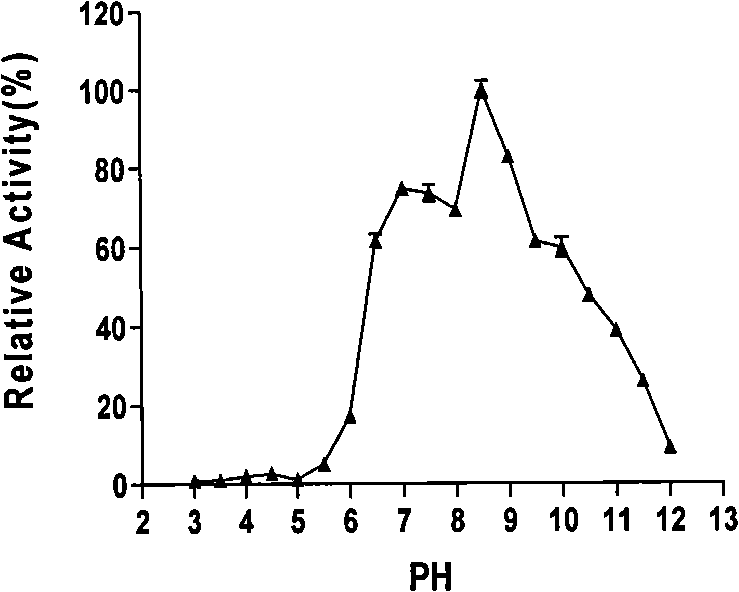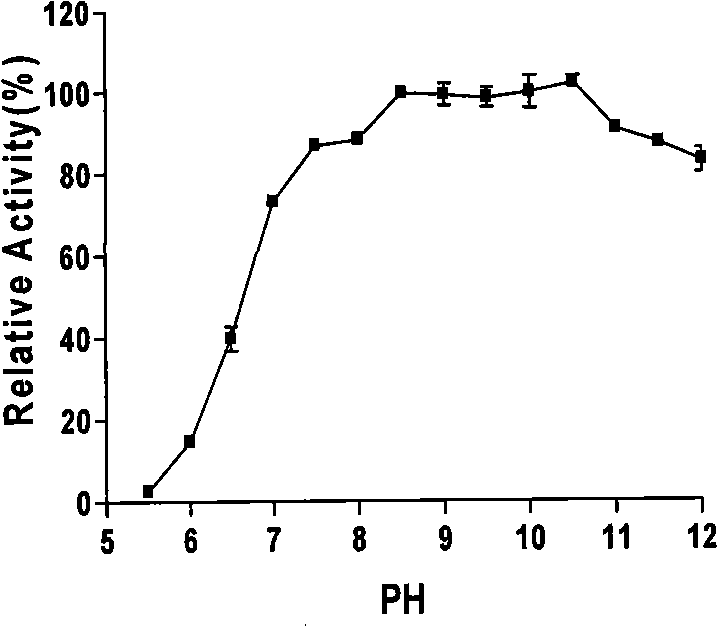Alkali-fast high-activity alkalescent xylanase and encoding gene thereof
A xylanase, high-activity technology, applied in the field of genetic engineering, can solve the problems of insufficient enzyme tolerance, low xylanase yield, restriction of large-scale use of enzymes, etc.
- Summary
- Abstract
- Description
- Claims
- Application Information
AI Technical Summary
Problems solved by technology
Method used
Image
Examples
Embodiment 1
[0019] Embodiment 1 produces the screening method of the natural bacterial strain of xylanase
[0020] The marine bacterial strains (a total of 100 bacterial strains) provided by the China Marine Microorganism Culture Collection Center (Address: No. Sodium chloride, pH 7.0) after activation on the plate, single colonies were picked out on the enzyme-producing medium (1% xylan, 1% peptone, 1% yeast culture, 2% sodium chloride (NaCl), 0.2% phosphoric acid Dipotassium Hydrogen (K 2 HPO 4 ), 0.03% magnesium sulfate (MgSO 4 ), 0.02% calcium chloride (CaCl 2 ) and 1.5% agarose, pH 7.0) plate, cultured at 28°C for 36 hours, stained with 1% Congo red for 10-15 minutes, then decolorized with 1M NaCl, and picked the strains that produced larger transparent circles. After this experiment, a strain of Kocuria sp. Mn22 belonging to the genus Actinomyces was screened out, and the strain was named Kocuria sp.Mn22 for subsequent experiments.
Embodiment 2
[0021] The construction of embodiment 2 DNA library and the screening of xylanase positive clone
[0022] 1. Extract bacterial chromosomal DNA:
[0023] (1) The Kocuria sp.Mn22 bacterial strain screened in the embodiment is cultured with the high-salt LB liquid described in Example 1 after cultivating at 28°C for 24 hours, then take 1.5ml of bacterial liquid in a sterilized Ep tube, 12000 rpm Centrifuge for 1 minute, discard the supernatant, and collect the bacteria;
[0024] (2) Wash the bacteria twice with TE buffer (50mmol / LTris-HCl pH8.0, 10mmol / LEDTA pH8.0), then add 50μl 100μg / ml lysozyme (purchased from sigma company) to suspend the bacteria, and bathe at 37℃ One hour;
[0025] (3) Add 520 μl TE buffer, 30 μl 10% SDS and 3 μL 20mg / ml proteinase K (purchased from sigma company) and mix well, then bathe in water at 37°C for one hour;
[0026] (4) Then add 100 μl of 5mol / L sodium chloride solution and mix well, then add 80 μL of cetyltrimethylamine bromide (CTAB) / sodium...
Embodiment 3
[0044] The method for cloning, expressing and purifying xylanase Kxyn in Escherichia coli of embodiment 3
[0045] Construction of recombinant expression vector pGEX-6P-Kxyn:
[0046] According to the sequencing results, design primers, the sequence of the primer pair is as follows:
[0047] Forward primer (F): 5'-(BamHI)-ACC GGATCC ATGAGCAGACGAGCCCCCCT
[0048] Reverse primer (R): 5'-(EcoRI)-GCG GAATTC TCAGCGGAACGCGGGGT
[0049] Kxyn was amplified by PCR using pUC-Kxyn as a template. The PCR system is as follows:
[0050] 10×PCR buffer (purchased from TAKARA company) 5 μl
[0051] Mncl 2 (5mM) 3μl
[0052] dNTP (10mM) 1μl
[0053] Template plasmid pUC-Kxyn 1μl
[0054] Forward primer F (10μM) 1μl
[0055] Reverse primer R (10μM) 1μl
[0056] Taq DNA polymerase (purchased from Takara Bioengineering (Dalian) Co., Ltd., namely TAKARA, 2.5U / μl) 1 μl
[0057] Add deionized water to 50 μl
[0058] PCR conditions: 95°C pre-denaturation for 4 minutes; 95°C for 40 seco...
PUM
 Login to View More
Login to View More Abstract
Description
Claims
Application Information
 Login to View More
Login to View More - R&D
- Intellectual Property
- Life Sciences
- Materials
- Tech Scout
- Unparalleled Data Quality
- Higher Quality Content
- 60% Fewer Hallucinations
Browse by: Latest US Patents, China's latest patents, Technical Efficacy Thesaurus, Application Domain, Technology Topic, Popular Technical Reports.
© 2025 PatSnap. All rights reserved.Legal|Privacy policy|Modern Slavery Act Transparency Statement|Sitemap|About US| Contact US: help@patsnap.com



